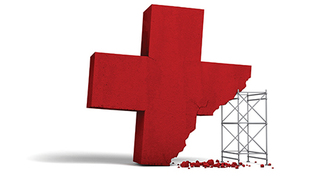 loading
loading
Yale vs Covid Richard BorgeView full imageHealth care at risk By Sten Vermund These are unprecedented times for america’s society and economy, as well as its healthcare and public health sectors. Combining elements of the 1918–19 influenza pandemic with an economic meltdown reminiscent of the early months of the Great Depression is not where we wanted our beloved country to be in 2020. What will we learn from this trauma? For decades, I have seen the public health infrastructure deteriorate in our nation and in many lower-income nations worldwide. Infectious-disease screening and contact-tracing activities are less vibrant in critical areas such as sexually transmitted infections or tuberculosis than was the case in the 1970s when I was in medical school. Warnings were delivered over at least three decades as to the urgent need to prepare for pandemic respiratory viral assaults, yet they were largely ignored by policymakers. We did not have adequate personal protective equipment (PPE) such as masks, or enough ventilators, or surge capacity for hospital beds, or enough allied health workers, or plans to decompress nursing homes and prisons. We did not heed the writing on the wall: namely, other coronaviruses, those that caused the common cold and the much more lethal SARS and MERS. When dangerous strains of coronavirus that had been seen in bats were found in humans, why did we not work in earnest toward drugs or vaccines? The private sector saw no profit and the public sector saw no need. Future historians of COVID-19 may cite the apocryphal Trojan princess, Cassandra, who was given prophetic powers by the Greek god Apollo but was condemned to have her prophecies disbelieved. Thousands of publications, dozens of books, and over 300 published review articles—all predicting the inevitable threat of pandemic respiratory virus—attest to the crystal-clear foresight of public health professionals, including our own CDC and NIH. In late 2018, Yale pediatrician and epidemiologist Warren Andiman published his book Animal Viruses and Humans: A Narrow Divide. His book’s subtitle read, “How lethal zoonotic viruses spill over and threaten us.” Why were our predictions not heard by captains of industry and powerful policymakers? Were we only talking to each other—scientists and health experts in our own communication bubbles? My self-criticism points to three key challenges. First, we must improve our ability to communicate complex forecasting to policymakers. It is not enough to predict a disaster; the message must be heard, and prevention and mitigation planned and financed. Second, to confront the emergence of future deadly microbes, we must make the comparatively modest investments needed to repair what is broken in our public health and health-care systems. Third, our schools of public health must not merely prepare graduates for technical competence but must also educate and train them to communicate effectively to lay audiences. Dare I say we need to learn “scientific marketing”—and soon? Won’t the public health threats of global climate change make the tragedy of COVID-19 look like the first mile of a 10,000-mile journey? Our collective future is uncertain. But also, there is abundant reason for optimism. As an infectious disease epidemiologist and pediatrician, I have tracked those elements of the public health response that have mitigated the worst of the pandemic. Here in Connecticut, I am immensely proud of the work being done by public health colleagues who are advancing science and informing the public and policymakers. Our community, spearheaded by our students and staff, has volunteered in a myriad of ways to help those in need. Hundreds of our alumni are on the front lines of the public health response, here in the US and at points around the world. In early March, when Chinese colleagues from Zhejiang University volunteered a teleconference to advise us as to their clinical and public health experience with COVID-19, we accepted. And to pay this favor forward, YSPH faculty have conducted educational sessions with African colleagues in Uganda, Burkina Faso, Sudan, Chad, Cameroon, and elsewhere to share our own experiences. Our Yale School of Public Health Emerging Infections Program now manages over 200 volunteers from Yale—mostly public health, medical, and nursing students—to help the state and local health departments with contact tracing. These efforts and many more have made tangible differences and remind us of the collective human instinct to help one another in times of need. The work goes on in many areas. The Yale School of Public Health is working with Volunteersurge.com, training laypeople to help in the work of tele-support, contact tracing, and assisting nurses. We have applied mathematics to infectious disease transmission dynamics, both to predict the future and to explain the past. We have helped develop new diagnostic assays and worked to make them amenable to convenient sampling, as with saliva. We have addressed issues of human rights, stigma, ageism, and social and racial/ethnic determinants of disease. We have advised governors and legislatures, schools and arts organizations, community and alumni groups, overseas ministries of health and local health departments. We have volunteered tirelessly to assist the homeless, those without food security, and the isolated elderly. But most importantly, in my view, we have educated and intervened. Masks, hand hygiene, physical distancing, outdoor activities, testing, and contact tracing in the short term, with informed policy and investments in the long term, all require a commitment to the social and collective good. It is not so difficult—yet America must transform itself to get there. Our field, our expertise, is protecting and improving health. We will strive to address the science skeptics effectively and to help raise prevention and public health to a national priority. Epidemiologist Sten Vermundis the dean of Yale’s School of Public Health.
|
|